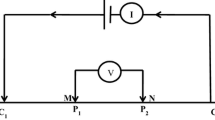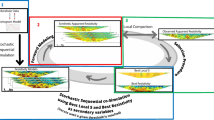Abstract
This paper describes the development of a forward solver and an inverse solver for modelling the resistivity distribution in electrical resistivity tomography. The forward solver is based on the finite integration technique and was developed to simulate and model synthetic resistance data. The inverse solver, the domain search algorithm, reconstructs the resistivity distribution within the subsurface by searching for a model that gives an acceptable fit to the simulated data. To find an optimum model that fits the simulated data, the domain search algorithm searches for the minimum of a multi-variable objective function by using a step-wise refinement approach. The forward and inverse solvers were developed as necessary forward and inversion modelling tools to enable the optimisation of electrode positions in resistivity imaging to be explored. Numerical results from implementing these solvers show that they are successful for simulating and reconstructing the resistivity distribution in electrical resistivity tomography.












Similar content being viewed by others
References
Binley A, Ramirez A, Daily W (1995) Regularised image reconstruction of noisy Electrical Resistivity Tomography data. In Proceedings of the 4th Workshop of the European Concerted Action on Process Tomography, Bergen, pp 401–410
Boubaki N, Saintenoy A, Tucholka A (2011) GPR profiling and electrical resistivity tomography for buried cavity detection: a test site at the Abbaye de l’Ouye (France). In Advanced Ground Penetrating Radar (IWAGPR), 6th International Workshop, 2011
Coggon JH (1971) Electromagnetic and electrical modeling by the finite element method. Geophysics 36(1):132–155
Dahlin T (1993) On the automation of 2D resistivity surveying for engineering and environmental applications: PhD thesis, Lund University
Dahlin T (1996) 2D resistivity surveying for environmental and engineering applications: First Break, 14, pp 275–283
Dahlin T, Loke MH (1998) Resolution of 2D Wenner imaging as assessed by numerical modeling. J Appl Geophys 38:237–249
Dey A, Morrison HF (1979) Resistivity modeling for arbitrarily shaped three- dimensional structures. Geophysics 44(4):753–780
Ellis RG, Oldenburg DW (1994) Applied geophysical inversion. Geophys J Int 116:5–11
Gautam PK, Biswas A (2016) 2D Geo-electrical imaging for shallow depth investigation in Doon Valley Sub-Himalaya, Uttarakhand, India. Model Earth Syst Environ 2:175. https://doi.org/10.1007/s40808-016-0225-4
Gunther T, Rucker C (2006) A general approach for introducing information into inversion and examples from DC resistivity inversion. EAGE Near Surface Geophysics Extended Abstracts, Helsinki
Hauer K, Potthast R, Wannert M (2008) Algorithms for magnetic tomography—on the role of a priori knowledge and constraints. Inverse Prob 24:1–18
Jenn D (1995) Radar and LASER CROSS SECTION ENGINEERING. American Institute of Aeronautics Education Series, Washington
Kress R, Kuhn L, Potthast R (2002) Reconstruction of a current distribution from its magnetic field. Inverse Prob 18(4):1127–1146
Lionheart W (2004) EIT reconstrution algorithms: pitfalls, challenges and recent developments. Physiol Meas 25:125–142
Loke MH, Barker RD (1996) Rapid least-squares inversion of apparent resistivity pseudosections by a quasi-Newton method. Geophys Prospect 44(1):131–152
Loke MH, Acworth I, Dahlin T (2003) A comparison of smooth and blocky inversion methods in 2D resistivity imaging surveys. Explor Geophys 34:182–187
Mufti IR (1976) Finite-difference resistivity modeling for arbitrarily shaped two dimensional structures. Geophysics 41(1):62–78
Munteanu I, Weiland T (2007) RF & microwave simulation with the Finite Integration Technique: from component to system design. Scientific Computing in Electrical Engineering: Mathematics In Industry, 11:pp 247–260
Olagunju E, Ariyibi E, Awoyemi M, Adebayo A, Dasho O, Adenika C (2017) Application of geochemical and geophysical approach to environmental impact assessment: a case study of Emirin active open dumpsite, Ado-Ekiti Southwestern Nigeria. Modelling Earth System and Environment. pp 1–13. https://doi.org/10.1007/s40808-017-0381-1
Oldenburg DW, Li Y (1994) Inversion of induced polarisation data. Geophysics 59(9):1327–1341
Panda B, Chidambaram S, Ganesh N (2017). An attempt to understand the subsurface variation along the mountain front and riparian region through geophysics technique in South India. 3(2): 783–797 https://doi.org/10.1007/s40808-017-0334-8
Petrov A (2008) Slow light photonic crystal line-defect waveguides. Cuvillier Verlag
Pidlisecky A, Haber E, Knight R (2007) RESINVM3D: A 3D resistivity inversion package. Geophysics 72(2):H1 -H10
Potthast R, Kuhn L (2003) On the convergence of the finite integration technique for the anisotropic boundary value problem of magnetic tomography. Math Methods Appl Sci 26(9):739–757
Pridmore DF, Hohmann GW, Ward SH, Sill WR (1981) An investigation of finite-element modeling for electrical and electromagnetic data in three dimensions. Geophysics 46(7):1009–1024
Singha K, Gorelick SM (2005) Saline tracer visualized with electrical resistivity tomography—field scale spatial moment analysis. Water Resour Res 41(5):1–17
Weiland T (1977) A discretization method for the solution of Maxwell’s equations for six-component fields. Electron Commun AEU 31(3):116–120
Weiland T (1985) On the unique numerical solution of Maxwellian eigenvalue problems in three dimensions. Particle Accelerators 17:227–245
Weiland T (1996) Time domain electromagnetic field computation with finite difference methods. Int J Numer Model Electron Networks Devices Fields 9(4):295–319
Weiland T (2003) RF & microwave simulators - from component to system design. 33rd European Microwave Conference, 2003
Author information
Authors and Affiliations
Corresponding author
Rights and permissions
About this article
Cite this article
Udosen, N.I., George, N.J. A finite integration forward solver and a domain search reconstruction solver for electrical resistivity tomography (ERT). Model. Earth Syst. Environ. 4, 1–12 (2018). https://doi.org/10.1007/s40808-018-0412-6
Received:
Accepted:
Published:
Issue Date:
DOI: https://doi.org/10.1007/s40808-018-0412-6




